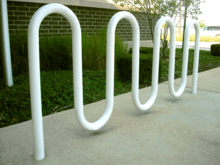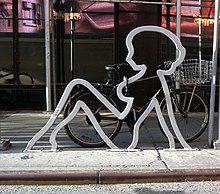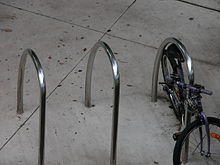Bicycle parking rack

A bicycle stand,[1] also called a bike rack,[2][3][4] is a device to which bicycles may be securely attached. It may be free standing or securely attached to the ground or some stationary object such as a building. Indoor bike racks are commonly used for private bicycle parking, while outdoor bike racks are often used in commercial areas. General styles of racks include the Inverted U, Serpentine, Bollard, Grid, and Decorative.[5] The most effective and secure bike racks, with the exception of the bike locker, are those that can secure both wheel and frame of the bicycle, using a standard U-lock or cable.
Bike racks can be constructed from a number of different materials. Durability, weather resistance, appearance, and functionality are extremely important variables of the material of the bike rack. Construction materials include stainless steel, steel, recycled plastic, or thermoplastic. Each material has advantages and disadvantages, and each is unique in appearance from the others.[5]
The visibility of the bike rack, adequate spacing from automobile parking and pedestrian traffic, weather coverage, and proximity to destinations are all important factors determining usefulness of a bicycle rack. These factors will help increase usage of the bike rack, and assure cyclists their bike is securely parked.[6]
History

Early models tend to offer a means of securing one wheel: these can be a grooved piece of concrete in the ground, a forked piece of metal into which a wheel of the bicycle is pushed, or a horizontal ladder providing positions for the front wheel of many bicycles. These are not very effective, since a thief need only detach the wheel in question from the bicycle to free the rest of the bicycle. They also do not offer much support, and a row of bicycles in this type of stand are susceptible to all being toppled in a domino effect. These types of stand are known as "wheel benders" among cyclists.
A modern version is known as the "Sheffield rack" or "Sheffield stand",[7] after Sheffield in England where these were pioneered. These consist of a thick metal bar or tube bent into the shape of a square arch. The top part is about level with the top bar of the bicycle frame, and thus supports the bicycle and allows the frame to be secured. The origin of the racks was when the frugal citizens of Sheffield had to decide what to do with some old gas piping. Local cyclists suggested the cycle rack idea and two simple bends later, and a little concrete in the ground, the rack was born. At the time this was a revolution in a world of 'single-point holders' that bent wheels and offered little lockability for frames. A High-quality versions feature a second, lower horizontal bar to support smaller bikes (this version is also known as “A stand”), and are coated to reduce their surface hardness and not scratch paint.
Since 1984 the City of Toronto has installed post and ring bicycle racks[8] consisting of a steel post topped by a cast aluminium ring.[9] In August 2006, it became publicly known that these stands could be defeated by prying the ring off with a two-by-four [1][dead link]
In Amsterdam two-tiered bicycle stands are ubiquitous. Bikes can be parked in a smaller area as the handlebars (usually wider than the back of the bicycle) of every other one is at a different height (either high or low). These racks are made of steel and have a large bar to which the frame may be easily locked. Most Dutch bicycles have a rear wheel lock, so that wheel need not be locked.
Classes
Bike parking needs vary from environment to environment.
Class I:
Some locations require Class I standards (commonly referred to as long-term bike parking). Class I parking regulations are implemented when bicycles will be parked for hours at a time. Examples of these environments are office buildings, elementary schools, libraries, etc. When implementing Class I bike racks, installers should also incorporate some form of weather protection for the racks and bikes.[6]
Class II:
More commonly seen in public areas are Class II bike racks. These bike racks are needed when cyclists will be leaving their bikes unattended for less than two hours. Weather protection is not as important for this class, however distance from main attractions should be considered to encourage usage. Class II bike racks can be implemented near fast food restaurants, parks, picnic areas, or other similar places.[10]


Styles
Many different styles of bike racks are available to match any environment. Specific details such as bolt size, tubing diameter, tubing style (square or round), height, length, and many other things vary with manufacturer, but typically, there are six general styles of commercial bike racks.

- U-Racks: A simple design, the inverted U Rack is the most basic bike rack present in commercial areas today. It is conveniently used in urban areas because it can be placed along sidewalks without taking too much space away from pedestrians, and also has a clean appearance that blends in well with other urban traffic structures.[11] Also known as: Staple rack
- Wave/Serpentine: The wave design of this bike rack is essentially an extension of the U-Rack. The waves allow for the storage and securing of more bicycles than the single U-Rack, while keeping it simple for bike riders to use. The familiar shape of this bike rack is identifiable to most cyclists, and does not take up a lot of room. However, the serpentine rack only supports a bicycle frame at one point (as opposed to two points with a U-rack), resulting in a greater chance of the bicycle falling over when parked in the rack.[11]
- Bollard Style: Bollards are short vertical posts most commonly used as traffic or parking barriers. Bollard style bike racks utilize this function and double its utility by adding one or two arms to secure bikes to. This style rack is beneficial if you’re trying to monitor pedestrian or driving traffic, or if you’re trying to complement an urban aesthetic with other parking signs, barriers, or traffic structures.[5]

- Grid Style: The fence style bike racks are primarily used for high volume bike storage situations. This style bike rack was more commonly used in the past, and is currently viewed as only appropriate for short-term bike parking where your bike remains in sight at all times. While it is useful in solving space issues, this bike rack does not allow both the wheel and frame of the bike to be locked, allowing for potential theft of the bicycle.[11]

- Innovative: Straying away from conventional bike rack designs, innovative designs incorporate both utility and style into its purpose. Many bike rack engineers have made small alterations to basic bike racks to improve functionality and appearance.[5]
- Decorative: Due to the unique nature of some commercial areas, some environments require a more decorative bike rack. For example, a public aquarium or zoo may prefer a shark shaped bike rack over a traditional style bike rack. While these bike racks may be interesting, it is important to keep in mind security and functionality of these designs.[5]
- Double Deck: Two-tier bike racks can be used to increase bicycle storage capacity in a fixed space. In order to easily maneuver a bicycle onto the top tier, some double deck bike racks incorporate hydraulic pistons to lift the bike into the rack after the user has locked it.
Mounts

Bike racks can be mounted to a surface in a number of different ways.
- In-ground: The base of the bike rack is planted into the ground, and secured by a perpendicular anchor pin for stability. These stable mounts are most secure from theft or vandalism.[5]
- Surface: Flanges extending outwards from the base of the bike rack are secured into existing concrete with lag bolts.[5] For added support, surface mounts can also include triangular brackets, also referred to as gusset plates, to reinforce the connection between the flange and tubing. Surface mounts with this extra support are called gusset mounts. Surface and gusset mounts are used to secure a bike rack into an existing piece of concrete.
- Rail mounts: Some bike rack units can be connected with rails. This type allows using single bike racks, while limiting the number of mounts be implemented. Rail mounts are mostly used to connect multiple ‘U’ Racks so each rack need not be mounted, saving labor costs and limiting the number of holes in the surface.[5]
- Wall Mounts: Certain bike racks are designed to be mounted to the wall using bolts to connect flanges of the rack onto existing walls. These conserve floor space and are most useful for long-term storage.
Finishes

Commercial bike racks can be constructed with a variety of different materials. Some of the most important factors to consider when choosing a finishing material are the weather conditions the bike rack will need to endure, the overall style and look of the atmosphere, the volume of bikes the rack will be holding, and environmental issues.
- Galvanized: Galvanized bike racks are the best value finish. They are inexpensive, and provide a thin layer of zinc for corrosion protection. The appearance is a dull gray color, with little to no shine.
- Powder-coat: This finish is usually available in a wide range of colors. It is achieved by a dry-powder coat that provides a durable outer layer that has a high gloss appearance and excellent weather resistance.

- Thermoplastic-coated: This polyethylene matte finish is usually available in a wide range of colors as well. The powder coating, applied for corrosion protection, can easily match existing surroundings, and creates a finish without runs or drips.[12]
- Recycled Plastic: Recycled plastic bike racks are composed of 96% recycled materials. It does not splinter or crack, is more fire safe than wood, and does not emit harmful chemicals into the environment.
- Stainless Steel: Stainless steel is the most durable material for a bike rack. It has maximum corrosion protection, is antimicrobial, and has a glossy appearance that is easy to clean and maintain.[13]
- eSteel: The eSteel process produces a durable and uniform finish. The process is environmentally friendly, and is Occupational Safety and Health Administration and U.S. Environmental Protection Agency compliant.[5]
Installation

Where a bike rack is installed is just as important as how safe and useful it is. The better the location, the more use the bike rack will encourage. Bike racks should be installed in an area that is highly visible to the public. By avoiding isolated areas and hidden spaces, cyclists will feel safe enough to lock their bikes there. Crowded locations will also deter bike thieves from stealing bicycles. Also, by placing bike racks in a highly visible area, the location will most likely be near common places of interest, making it more convenient for people to ride their bike to their destinations.[6]
However, while a bike rack should be implemented in a visible area, it is important that the bike rack have adequate spacing away from pedestrians and other traffic. Bike riders will need ample space to maneuver their bike around and into the rack, without hitting other parked bikes, cars, or people. It is also important to place bike racks far enough away from doorways, sidewalks, or paths where it may obstruct traffic flow.[10]
Another important factor to consider is weather protection. If bike racks are being used for long-term parking, the bike rack should be placed under some form of weather protection. This will not only help protect the bike rack from corrosion, but also encourage bike riders to store their bikes there for extended periods of time.[10]
See also
- Bicycle carrier – a device to transport a bicycle with another vehicle.
- Bicycle lock - a device to secure a bicycle to a stand.
- Bicycle locker – a similar device, that offers even more security.
- Bicycle parking - general topic of parking bicycles.
- Bicycle tree - automated bicycle storage device.
- Luggage carrier – a device attached to a bicycle to facilitate carrying loads.
- Work stand - a tool for holding a bicycle still to facilitate working on it.
References
- ^ "Stand and Deliver, Cycle parking in London" (PDF). Greater London Authority. June 2009. Retrieved 9 September 2009.
- ^ "Bike Federation of Wisconsin, Bicycle Parking Services". Retrieved 27 December 2007.
- ^ "Transportation Alternative, On-Street Bicycle Parking: Bike Racks". Retrieved 27 December 2007.
- ^ "Bike Security Racks Co., Inc". Retrieved 27 December 2007.
- ^ a b c d e f g h i How to Buy a Bike Rack | Buying Guide." Belson Outdoors | Your Outdoor Superstore. Ed. Belson Outdoors. 1993. Web. 4 September 2009. <http://www.belson.com>.
- ^ a b c Pedestrian and Bicycle Information Center. "Bicycle Parking." Bicyclinginfo.org. U.S. Department of Transportation Federal Highway Administration. Web. 4 September 2009. <http://www.bicyclinginfo.org>.
- ^ "Cambridge Cycling Campaign, Glossary of cycle campaigning: Sheffield rack/stand". Retrieved 27 December 2007.
- ^ "Toronto: Bicycle parking - Choosing a rack". Retrieved 27 December 2007.
- ^ "Toronto: Bicycle parking - Recommended racks". Retrieved 27 December 2007.
- ^ a b c Victoria Transport Policy Institute. "Bicycle Parking: Bicycle Parking, Storage, and Changing Facilities." TDM Encyclopedia. Victoria Transport Policy Institute (VTPI), 27 August 2007. Web. 4 September 2009. <http://www.vtpi.org/tdm/tdm85.htm>.
- ^ a b c Palmer Group. The path to great parking for your unique destination. Palmer Group, 1995. Web. 4 September 2009.
- ^ "Thermoplastic Powder for Outdoor Furniture." PF Online. Ed. Steven R. Kline. Gardner Publications, Inc, 2009. Web. 4 September 2009. <http://www.pfonline.com/>.
- ^ Speciality Steel Industry of North America. "Stainless Steel Overview: Features & Benefits." The Stainless Steel Information Center. SSINA. Web. 4 September 2009. <http://www.ssina.com>.
External links
- http://www.belson.com/bike-rack-buying-guide.htm
- http://www.bicyclinginfo.org/engineering/parking.cfm
- http://www.vtpi.org/tdm/tdm85.htm
- Japanese robotic multi-story bicycle stand
- Gallery of bike rack styles around the world
- Long term bike rack (vertical parking).
